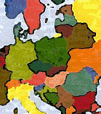Paul Samuelson, the Nobel Prize-winning economist, observed: "The word poverty means different things to different people." But what does it mean for Yugoslavia? In this difficult phase of coming to terms with the harsh realities of economic transition, can social and political forces muster the strength to formulate the policies needed to restore order and livelihood to this troubled area?
Noteworthy in the undertaking to eradicate poverty is a research study conducted by the World Bank in which a sample of 60,000 poor people from all over the world were considered. A simple yet truthful observation was made.
The report cites: "Poor people's lives are characterized by powerlessness and voicelessness, which limit their choice and define the quality of their interactions with employers, markets, the state and even NGOs. Institutions both formal and informal mediate and limit poor people's access to opportunities."
Without question, poverty hits some groups harder than others. Poverty is specific for a particular area, for a distinct group and for a certain household or individual. Unfortunately, no area in the world is immune from poverty.
In the World Economic Report for the year 2000, the World Bank gave the following data: 40 percent of the people in South Asia live below the poverty line, with average spending at just one dollar per day; 46 percent of the people in Sub-Saharan Africa live below the poverty line; 15 percent in East Asia and Pacific Rim; 16 percent in Latin America; 5 percent in Europe and Central Asia and two percent in the Middle East and Northern Africa.
According to the World Bank's report, the regions Europe and Central Asia were the only areas where poverty actually increased in the period between 1989 and 1998. It goes without saying that the events of the last decade in the ex-Yugoslavia contributed to this outcome.
Just how bad is the economic situation?
What is specific about the poverty in Yugoslavia today? First, as in most of the Southeastern Europe region, the Federal Republic of Yugoslavia (FRY) is traditionally less developed, and as a matter of history, a poor European area that has witnessed the spread of poverty in all sectors of social, economic and cultural life.
Second, the explosion of poverty in FRY between 1990 and 2000 is regarded as a unique trend in the world. Negative and destructive economic growth in the ten years that came after 45 years of relative high growth literally produced an unprecedented rate of the expansion of poverty in a very short period of time. Interestingly, during this same period of time, poverty was mainly stagnating or declining around the rest of the world.
What happened in FRY? The last decade in Yugoslavia's history was not only decade of retrograde political thinking and behavior, it was also a decade of a new kind of economic practice. Producing only a seven percent average rate of economic growth, in ten years' time, FRY offers a unique case in Europe and probably worldwide in terms of economic behavior in the 20th century.
Contrary to popular global economic practices, Yugoslavia centralized its decision making processes, spreading a "distributive economy" into the public sector and backing Mafia-led economic institutions and actions-wild banks, pyramid savings scams, etc.
The product of that new economic practice, combined with the political destruction of the past 13 years is very clear: today around one-third of Yugoslav citizens live below the poverty line and on just one USD of spending per day.[1] This poverty figure is not to be taken lightly; it is six times greater than the five percent European average. Equally alarming is the fact that most likely another one-third of people in FRY survives on somewhere between one and five USD per day.
During the former regime, hyperinflation practically destroyed the middle class in less than two years and most members of the middle class became part of the entrenched poverty class. At the beginning of 2000, 503,000 refugees were registered in Yugoslavia and 211,000 internally displaced persons were accounted for, nearly all of them living in poverty.
The United Nation's "Humanitarian Risk Analysis" revealed in September 1999 that as many as 75 percent of the examined people stated that their income was not sufficient for their basic needs. Moreover, according to recent research of the Center for Alternative Studies, 85 percent of respondents indicated that their economic position has drastically deteriorated in the last decade.
The research to support this sentiment is underscored in a United Nations Development Programme (UNDP) Early Warning Report from January of this year. The UNDP assessed that the impoverished population in Central Serbia and Vojvodina constitute approximately 46 percent of the total population of this area both by the criteria of one USD spending per person daily and for the kinds of goods that fill their "consumer basket."[2]
Poverty awareness
Poverty issues have captured increasing attention all over the world. Poverty—in all its forms—is the greatest challenge to the international community today. United Nations conferences and summits in the 1990s sought to reduce poverty globally and set seven development goals for the entire world. Each of the seven goals addresses one aspect of poverty. The goals are set in precise terms and measured in numbers to ensure accountability.
The first and most important goal is to reduce the proportion of people living in extreme poverty by half between the years 1990 and 2015. The goals will not be easy to achieve but progress is already recorded in some areas.
China reduced poverty figures from 360 million in 1990 to about 210 million in 1998. Significant cuts its military budget and heavy investment in health and education also helped. Between 1988 and 1996, the rate of growth of Thailand's economy was seven percent and the population poverty level dropped from 22 percent to 11 percent. Worldwide, the number and proportion of people living in extreme poverty declined slightly through mid-1990s. The message from this and other successes is clear: if some countries can make great progress towards reducing poverty, others can as well.
Getting people to pay attention
Why the same trend did not happen in Yugoslavia is indicative of the past decade's economic debacle. More to the point, however, is questioning why Yugoslavia still doesn't have a poverty reduction strategy today.
There are two main reasons: First, the awareness of the magnitude and importance of poverty as a pressing problem is low. Secondly, the present approach to poverty in Yugoslavia is too pro-social oriented rather than being growth-oriented.
On the first reason proof is evident. Media research agencies like Strategic Marketing and the Media Center in Belgrade have regularly monitored media coverage of dominant themes in Yugoslavia since August 2000. Sometimes what is not discussed can be the most revealing.
In the period 5 October 2000 (end of Milošević's reign of power) to 28 February 2001, the top ten issues for Yugoslav media were:
- Political problems between Albanians and Serbs in Kosovo (southern region of Serbia)
- Reactions on new government performances
- Montenegro
- Federal Government activities
- Financial help from abroad and monetary problems
- Activities of President Koštunica
- December 2000 Serbian federal elections
- Prices, exchange rate, standard of living
- Relations between Yugoslavia and the Hague tribunal
- Police activities
There was no specific mention of poverty; only "standard of living" and day-to-day life uncertainties were registered. Of course this is not just the fault of journalists. Politicians impose political problems and themes and journalists report them.
It is obvious that poverty is not high on the agenda of today's Yugoslav politicians. This could be a consequence of their inability to realistically assess the economic and political situation or their inability to identify Yugoslavia's pressing priorities. It should not be forgotten that the former regime was overthrown primarily because people were fed up with long-lasting poverty.
The problem of poverty reduction is not only a social and economic problem; it is also a very important—if not the most important—political problem of Yugoslavia today. Politicians should declare war on poverty in FRY. The phenomenon of poverty should overpower other political topics and become one of the top agenda policy issues instead of being treated as marginal issue.
Economic aspects
In terms of orientation of economic growth as a poverty reduction remedy, how should poverty be addressed in Yugoslavia? The primary responsibility for finding solutions for poverty lies in a country itself. The strategy chosen to reduce poverty must be extensive enough to attack all its main causes.
Today most economists dealing with poverty problems believe that pro-poor sustainable economic growth and social development are key elements of a poverty reduction strategy.[3] Growth is sustainable if the majority are able to benefit from it. Without this, poverty will continue to feed social and political tensions. But this can be done only through sensible macroeconomic management.
So we come to three conditions for success:
- social development
- sound macroeconomic management
- pro-poor economic growth
In Yugoslavia, the area of social development has seen the most activity. With substantial help from Western countries, results in the social sector are obvious and more or less well-known to the public.
As far as macroeconomic management is concerned, which goes together with the other two conditions for success, a clear picture remains to be seen, but it is obvious that a lot of effort is being directed towards reaching that goal.
Labor-absorbing growth and the resulting expansion of employment bring large numbers of the poor into economic activity, with important repercussions for poverty reduction. This type of growth reduces poverty by generating employment and income.
Pro-poor growth also generates incentives for creating a healthy environment for private sector development and for development of programs that produce income-generating opportunities for poor people and endangered groups, such as micro-finance or programs for self-employment.
In need of a strategy
How can FRY develop the right conditions for pro-poor economic growth? A first step is to have a clear picture of the magnitude and structure of the problem of poverty in Yugoslavia. Despite a lot of research undertaken to date by different domestic and foreign groups, the available data is not sufficient.





